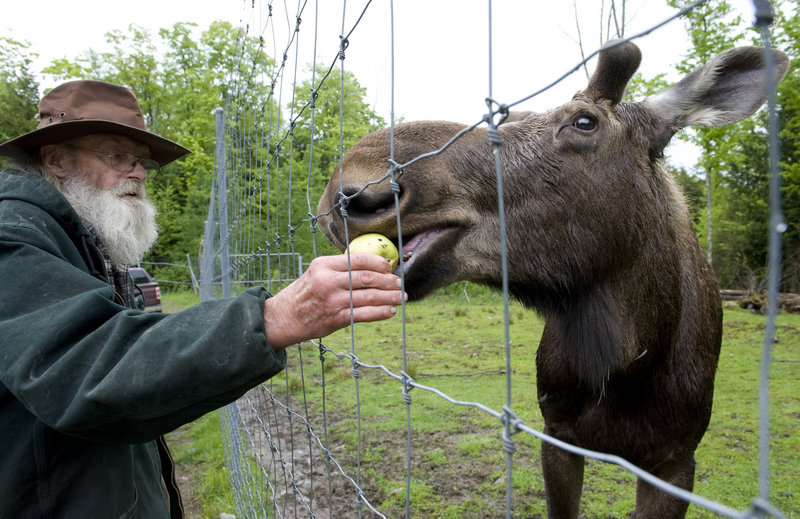IRASBURG, Vt. – Pete the Moose munched on apples, bananas and a Snickers candy bar — he won’t eat a Milky Way — blissfully unaware of his near-demise.
Vermont’s favorite animal, ordered removed last year from a game preserve or destroyed, will now be allowed to stay on the land near the U.S.-Canada border under a compromise fashioned by state lawmakers in the waning hours of their session last week.
The turnabout came after the 700-pound moose’s tale of woe went viral, prompting a “Save Pete the Moose” website, a Facebook page (more than 4,000 people “like this” as of Friday afternoon), about 10,000 YouTube views and a rally at Vermont’s statehouse.
“It’s the best I could’ve hoped for,” said David Lawrence, 74, who nursed the moose to health and tends to him at the Big Rack Ridge preserve. “They wanted to kill Peter.”
The fenced-in 700-acre preserve, which charges hunters to kill trophy elk, is also home to white-tailed deer and a handful of moose – including Pete. He was adopted as a calf after dogs attacked his mother and a sibling.
Lawrence, a soft-spoken, white-bearded animal lover who keeps a menagerie of animals at his home, offered to tend to the animal and has raised him since then, monitored by preserve owner Doug Nelson.
Pete, who follows Lawrence when he visits, spends his days noshing on birch and maple trees, as well as on the treats that Lawrence brings him, which include hay, apples and the occasional candy bar.
Last summer, the Vermont Department of Fish and Wildlife said Pete and other native deer and moose living in the compound shouldn’t be mixing with the farm-raised elk because of fears that tuberculosis or chronic wasting disease — a brain ailment — could be spread, though neither had been found there.
The state said either the preserve would have to close or Pete and the other animals would have to be put down. The issue wasn’t focused on the moose, but on the fact that the preserve mixes imported elk with native moose and deer.
“You wouldn’t want to release them into the wild because what if they’ve been exposed to something from the captive elk? Then they’d spread it to the whole whitetail population,” said assistant state veterinarian Michael Wood.
In their annual session, which ended May 12, Vermont lawmakers crafted a compromise. In it, the animals at the Big Rack Ridge preserve were designated a “special-purpose herd,” oversight of which was transferred from Fish and Wildlife to the state Agency of Agriculture.
Nelson, in turn, was told to come up with a management plan and fortify the 8-foot wire fencing with a parallel fence that ensures the animals in the compound can’t get out, other animals can’t get in and the two populations never have “nose to nose” contact.
The moose, for his part, is ignorant of the fate he dodged, said Nelson, a 68-year-old dairy farmer.
The animal certainly looked it Wednesday, as Lawrence hand-fed him through a fence, reflecting on the reprieve.
“He just does his thing every day,” Lawrence said.
Send questions/comments to the editors.



Success. Please wait for the page to reload. If the page does not reload within 5 seconds, please refresh the page.
Enter your email and password to access comments.
Hi, to comment on stories you must . This profile is in addition to your subscription and website login.
Already have a commenting profile? .
Invalid username/password.
Please check your email to confirm and complete your registration.
Only subscribers are eligible to post comments. Please subscribe or login first for digital access. Here’s why.
Use the form below to reset your password. When you've submitted your account email, we will send an email with a reset code.